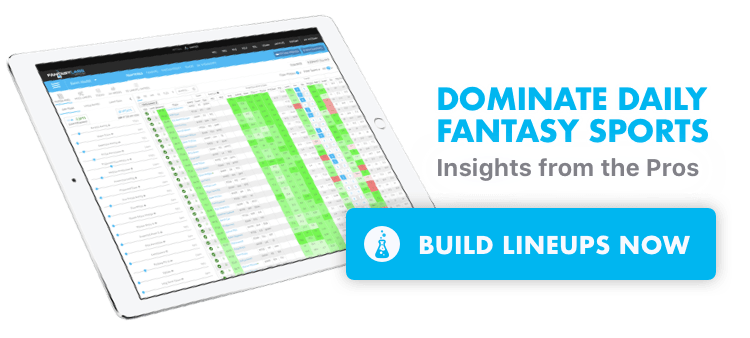The Week 3 NFL main slate kicks off on Sunday, Sept. 22, at 1 p.m. ET. In this piece, I highlight the running backs who stand out in our large suite of analytical DFS Tools, most specifically the industry-leading FantasyLabs Models.
For updates on Vegas spreads and over/unders, check out The Action Network Live Odds page.
Top Running Backs in the FantasyLabs Models
There are five running backs atop the individual Pro Models that Jonathan Bales, Peter Jennings (CSURAM88), Adam Levitan, Sean Koerner, Chris Raybon, Kevin McClelland (SportsGeek) and I have constructed.
- Ezekiel Elliott: $8,900 DraftKings; $8,800 FanDuel
- Christian McCaffrey: $8,700 DraftKings; $8,900 FanDuel
- Chris Carson: $5,900 DraftKings; $7,000 FanDuel
- Peyton Barber: $4,600 DraftKings; $6,100 FanDuel
- Phillip Lindsay: $4,300 DraftKings; $6,400 FanDuel
Ezekiel Elliott: Dallas Cowboys (-21.5) vs. Miami Dolphins, 47 Over/Under
Two weeks ago, Zeke was on a beach in Cabo “working out” with Marshall Faulk, and fantasy investors were worried that his holdout might extend into the regular season.
One $90 million contract extension and two warmup games later, Zeke is ready to be locked into daily fantasy lineups. After the appetizers of Weeks 1-2, he is officially ready for the entrée: It’s Zeke week — time to eat.
I will probably die believing that the Cowboys shouldn’t have drafted Elliott No. 4 overall in the 2016 draft, but as a fantasy producer, he’s elite. Since he entered the league in 2016, only Le’Veon Bell and Saquon Barkley have averaged more FanDuel points per game than Zeke’s 19.0 (including playoffs).
In each of the past three seasons, Zeke has led the NFL in rushing yards per game (108.7, 98.3 and 95.6), and last year he was No. 1 with 26.6 opportunities (carries plus targets) per game.
Even though he sat out Week 17, Zeke led the league in 2018 with 381 touches and was a close second to Saquon with 2,001 scrimmage yards. Not once last year did Zeke fail to get 18 touches in a game. Since his rookie campaign, Zeke is the only back to average more than 100 yards rushing per game with his mark of 100.3. In fact, Elliott is second all time with his per-game rushing average, trailing only Hall-of-Famer Jim Brown, who has 104.3.
For the first two weeks of 2019, Zeke has been working his way back into shape and into the offense of new coordinator Kellen Moore.
- Week 1 (vs. Giants): 12.8 FanDuel points, 54.4% offensive snaps, 13-53-1 rushing, 1-10-0 receiving on two targets
- Week 2 (at Redskins): 19.0 FanDuel points, 75.7% offensive snaps, 23-111-1 rushing, 2-9-0 receiving on two targets
Given his escalating recent usage, it’s likely Zeke in Week 3 will have a snap rate in excess of 85%, a threshold he surpassed in all but two games played last year.
Zeke has a great matchup against the Dolphins, who are in full-on tank mode. In Weeks 1-2, they allowed an NFL-record 102 points. Gone from last year’s front seven are edge defenders Cameron Wake and Robert Quinn, tackle Akeem Spence and linebacker Kiko Alonso. Meanwhile, the Cowboys offensive line is better than it was last year thanks to the return of All-Pro center Travis Frederick (Guillain-Barre Syndrome) and development of second-year left guard Connor Williams.
Through two weeks, the Cowboys have a 100% success rate on power runs, and the Dolphins on defense have a league-worst stuffed run rate of 12% (per Football Outsiders). The running game that can’t be stopped is facing the stop unit that can’t stop sucking.
The Cowboys have a slate-high 34.5-point implied Vegas total, and lead backs over the past two weeks have turned the Dolphins into chum.
- Mark Ingram (Week 1 at Dolphins): 22.7 FanDuel points, 14-107-2 rushing
- Sony Michel (Week 2 at Dolphins): 12.5 FanDuel points, 21-85-1 rushing
And this is to say nothing of the 17 carries Gus Edwards and receiving touchdown Patrick Ricard had in Week 1 or the 68 yards Rex Burkhead and 29 yards and a touchdown James White got in Week 2.
Add it all together, and the Dolphins this year have allowed opposing backfields to average 31.0 FanDuel points per game — the second-highest mark in the league.
Cash games, guaranteed prize pools, whatever: Zeke is going to be popular — and he should be.
Zeke is the No. 1 back in the Bales, CSURAM88, Levitan, Koerner, SportsGeek and Freedman Models for FanDuel, where he has a position-high 16 FanDuel Pro Trends and 97% Bargain Rating.
Christian McCaffrey: Carolina Panthers (-2.5) vs. Arizona Cardinals, 46.5 O/U
There’s a lot of uncertainty surrounding the Panthers offense. Quarterback Cam Newton (foot) missed practice on Tuesday and seems increasingly unlikely to play due to a preseason injury he aggravated last week on Thursday Night Football.
If Newton can’t go, the Panthers will reportedly turn to Kyle Allen, a second-year backup who entered the league as an undrafted free agent. With Newton out, the ceiling for the entire Panthers offense will be lower, and that will impact McCaffrey.
Probably. But maybe not.
Last year Allen was surprisingly not horrible as the backup: He had a 64.5% completion rate and 9.9 adjusted yards per attempt. In his one start, the Panthers scored 33 points. Granted, it came in Week 17 against a Saints team resting its starters — but it’s not as if Newton has played well in 2019. The drop-off from Newton to Allen may not be as severe as we’d expect.
Additionally, with Allen at quarterback, the team might funnel to McCaffrey even more opportunities, which could counterbalance the negative offensive repercussions of Cam’s absence.
So even though Newton might miss Week 3, McCaffrey still is in play: He leads the slate with his median and floor projections, and he has almost no competition for backfield touches. Last year, he played an obnoxious 91.3% of his team’s offensive snaps, and this year he’s bumped his snap rate up to 100%. He is the Panthers offense.
Even though McCaffrey was just No. 17 last year with 13.7 rushing attempts per game, he more than made up for his ground-game dearth with a position-high and team-best 124 targets, 107 receptions, 867 yards receiving and 842 yards after the catch.
In 2018, McCaffrey was easily a top-three fantasy back with 25.3 DraftKings and 20.8 FanDuel points per game. In offensive coordinator Norv Turner’s surprisingly modern system, he #McCrushed.
To start 2019, McCaffrey has been an uneven producer.
- Week 1 (vs. Rams): 45.9 DraftKings points, 19-128-2 rushing, 10-81-0 receiving on 11 targets
- Week 2 (vs. Buccaneers): 7.3 DraftKings points, 16-37-0 rushing, 2-16-0 receiving on six targets
But McCaffrey leads all backs with his 47.2 expected fantasy points (per the RotoViz NFL Stat Explorer), and each year of his career, he’s become more efficient as a runner, based on his fantasy points over expectation per attempt (per the RotoViz Screener).
- 2019: 0.18
- 2018: 0.07
- 2017: -0.05
Pound for pound, he might be the league’s best all-around back.
It’s notable that through two weeks, the Cardinals haven’t been run over by opposing backfields. But that probably has more to do with circumstances than with any ability they have to shut down a running game. In Week 1, they faced a poor Lions rushing attack, and in Week 2 they were ravaged by quarterback Lamar Jackson, who had 120 yards on the ground.
Although the Cardinals have held opposing backfields to just 15.5 DraftKings points per game, we haven’t seen anything to suggest that they can stop a top-tier three-down back: They rank No. 24 with a 62.0 run-defense grade (per Pro Football Focus).
Like Elliott, McCaffrey is very much in play for both cash games and tournaments: It’s an old-school “Jam ‘Em In” type of week.
McCaffrey is the No. 1 back in the Levitan and SportsGeek Models for DraftKings, where he has a position-high nine Pro Trends. He’s also the top option in the Raybon Model for FanDuel, where he leads all players with his +5.59 Projected Plus/Minus.
Chris Carson: Seattle Seahawks (-4.5) vs. New Orleans Saints, 45 O/U
I’m an old-school Rashaad Penny truther, so the petty part of me doesn’t want to see Carson dominate the Seattle backfield.
But the pragmatic side of me knows that this is a great spot for Carson to smash.
Under head coach Pete Carroll, the Seahawks at home are 46-30-3 against the spread (including playoffs), good for an A-graded 18.0% return on investment (per Bet Labs). They have one of the best home-field advantages in the league.
As the locked-in lead back since last season, Carson has directly benefited from the team’s home dominance, seeing an overabundance of extra fantasy production at CenturyLink Field.
- Home (nine games): 17.9 DraftKings points, +7.22 Plus/Minus, 88.9% Consistency Rating
- Away (eight games): 12.4 DraftKings points, +1.51 Plus/Minus, 50.0% Consistency Rating
At home, Carson is always worthy of cash-game consideration.
Since last year, when run-oriented offensive coordinator Brian Schottenheimer joined the team, the Seahawks have led the league with a bellicose 51.9% rush rate (including playoffs). When they have the opportunity to run, they do, and that organizational will to rush has endowed Carson with an enviable workload. Despite missing two games in 2018, Carson was No. 7 in the league with 247 carries. And overall, he was No. 3 with 17.6 attempts per game.
With that kind of volume, even if Carson isn’t efficient, he can still produce — and that’s a lucky fact, since he has been somewhat wasteful with his opportunities to start the year. He has scored touchdowns but failed to convert touches into significant yards.
- Week 1 (vs. Bengals): 25.1 DraftKings points, 15-46-1 rushing, 6-35-1 receiving on seven targets
- Week 2 (at Steelers): 10.7 DraftKings points, 15-60-0 rushing, 3-27-0 receiving on three targets
It’s easy to see how far 15 carries and five targets per game can carry a back. With his usage, Carson is No. 5 among all backs with 32.0 expected fantasy points this year.
So he’s at home, and he’s going to get the ball. Additionally, he has a good matchup: The Saints defense is dead last with a 26.4% run DVOA, and it will have diminished support from the offense, which could struggle to keep drives going without quarterback Drew Brees (thumb). And if the Saints falter on offense, that will create extra opportunities for Carson and the Seahawks to put up fantasy points.
Carson is the No. 1 back in the Raybon Model for DraftKings, where he has a position-high +5.40 Projected Plus/Minus.
Peyton Barber: Tampa Bay Buccaneers (-6.5) vs. New York Giants, 47.5 O/U
I always feel dirty writing about Barber, especially since whenever he pops in one of the Models, it’s always mine. There have been 18 regular season games since last season: Barber has been the No. 1 back in my DraftKings Model for half of them. That’s ridiculous.
Maybe I should tweak my Model — but his incessant presence in this weekly piece speaks to his sustained value. He’s never a guy I actually want to roster, but he usually deserves a higher DFS salary and GPP ownership rate.
I don’t want to oversell: Since last season, Barber has without question been the stone-cold worst starting back in the league, averaging just 9.8 DraftKings points per game. Just four times over the past 18 games has he scored more than 15 DraftKings points.
But he’s still had a +2.99 Plus/Minus and 55.6% Consistency Rating in that time. He’s not worthless.
And even though he might be less talented than Ronald Jones II as a runner and Dare Ogunbowale as a receiver, he still played 64.6% of the offensive snaps last week in a tight game. Last week, no back saw more carries than Barber did with 23, which he turned into 82 yards and a touchdown. Those are modest production totals, but Barber is still the guy getting the bulk of the opportunities in the Bucs backfield: He’s still the lead back.
Additionally, since becoming the lead back in Week 13 of the 2017 season, Barber has been at his best with quarterback Jameis Winston instead of Ryan Fitzpatrick, exhibiting notable quarterback-based splits. While these splits are apparent even in the games with quarterback changes, I’ve removed such games from the sample so the trend can be better seen.
- Barber with Winston (15 complete games): 11.4 DraftKings points, 15.5 carries, 2.4 targets, 1.9 receptions, 70.2 yards, 0.40 touchdowns
- Barber with Fitzpatrick (five complete games): 5.5 DraftKings points, 13.4 carries, 1.6 targets, 0.8 receptions, 47.4 yards, zero touchdowns
Now that Fitz is with the Dolphins and Winston is locked in as the starter, perhaps Barber will be more reliable.
Barber has several things going for him this week.
First, even though the Bucs have offensively underwhelmed, they have an upside-laden offense with an aggressive-minded head coach in Bruce Arians. As the lead back for this team, he should get opportunities to score touchdowns.
Also, he could enjoy an extremely run-heavy game script as a sizable home favorite. Last week, the Bucs had 31 run plays to 25 pass plays, and if they get out to an early lead, they could once again have a similar run/pass split, which would likely benefit Barber.
Additionally, the Bucs played on Thursday Night Football in Week 2. Compared to the Giants, they’ve had three extra days to rest and prepare for the game.
Finally, the Bucs are facing the Giants, who have struggled against the run this year: In two games, they’ve already allowed three backs with double-digit DraftKings points. And last year, Barber had the best game of his season against the Giants in Week 11, scoring 22.0 DraftKings points with 110 yards and a touchdown on 18 carries and two receptions.
As unreal as this sounds, Barber actually has 100-yard, two-touchdown upside against the Giants and will likely have a rock-bottom ownership rate in tournaments.
Barber is the No. 1 DraftKings back in the Freedman Model.
Phillip Lindsay: Denver Broncos (+7.5) at Green Bay Packers, 47.5 O/U
Last year, Lindsay was such an unlikely success story: A small, undrafted rookie coming from nowhere to lead his team with 1,278 yards and 10 touchdowns from scrimmage. He was second among all qualified backs with 5.4 yards per carry and was the league’s third-most north/south runner with a 3.39 Efficiency Rating (per Next Gen Stats). Few rushers last year were as explosive as he was through the line of scrimmage.
And it’s not as if his production was a fluke. Although he was undrafted, he was a good, underappreciated prospect.
- He has good speed: He ran a 4.39-second 40-yard dash at his pro day.
- He was productive in college: Across his three seasons as a lead back, he averaged 1,450 yards and 13 touchdowns from scrimmage.
- He is a good receiver: In college, he had a 117-1,084-3 pass-catching stat line.
He’s a legit player.
But this year he has three problems.
Whereas Lindsay played as the clear lead back in the second half of last season, teammate Royce Freeman has forced a nearly even time share this year.
- Phillip Lindsay (per game): 50% snap rate, 12.0 carries, 6.5 targets
- Royce Freeman (per game): 50% snap rate, 10.5 carries, 4.0 targets
Lindsay still has the edge in usage, but it is slight.
And even with less volume, Freeman has actually outproduced Lindsay (163 yards vs. 132), as Lindsay has predictably regressed in his efficiency while Freeman has progressed.
- Phillip Lindsay: 2018 – 5.4 yards per carry, 5.1 yards per target; 2019 – 3.3 yards per carry, 4.1 yards per target
- Royce Freeman: 2018 – 4.0 yards per carry, 3.6 yards per target; 2019 – 5.2 yards per carry, 6.6 yards per target
With fewer yards per opportunity, Lindsay is far less likely to return value if he’s sharing more of the backfield work with Freeman.
Finally, as bad as the Broncos offense was last year, it might be even worse this year for the running backs with new quarterback Joe Flacco and coordinator Rich Scangarello.
- 2019: 15.0 points per game, 1.72 points per drive, 92.5 rushing yards
- 2018: 20.6 points per game, 1.74 points per drive, 118.9 rushing yards
Because of these factors, it’s hard to get all that excited about Lindsay, especially because he’s a big road dog — but that’s probably what he has going for him the most this week.
Last year, Lindsay had reverse home/road and favorite/dog splits.
- Home/Road Splits (DraftKings points per game): 14.4 vs. 16.4
- Favorite/Dog Splits (DraftKings points per game): 15.4 vs. 16.2
And these splits make sense: He’s likelier to be a dog when he’s on the road. He’s likelier to have a pass-leaning game script as a dog. And as a receiver, he scores more fantasy points per opportunity.
The big edge Lindsay still has over Freeman is that he’s the team’s primary pass-catching back. If the Broncos play from behind for most of the game against the Packers, Lindsay could see most of the offensive snaps.
And the matchup is actually a good one for Lindsay: In 2018, the Packers were dead last against running backs with a 25.1% pass DVOA. If Lindsay spends most of his snaps running routes on Sunday, that could be a big boon for his fantasy production.
I wouldn’t touch Lindsay in cash games, but he will have minimal ownership in tournaments, and his pass-catching ability and opportunity give him an undervalued upside.
Lindsay is the No. 1 back in the Bales, CSURAM88 and Koerner Models for DraftKings.
Upside Running Backs for Guaranteed Prize Pools
Saquon Barkley, New York Giants ($9,100 DK, $9,200 FD): Barkley has 100-plus yards rushing and six-plus targets in each game this year, and the Giants offense could get a boost from rookie quarterback Daniel Jones.
Alvin Kamara, New Orleans Saints ($8,000 DK, $8,000 FD): Kamara is likely to have drastically reduced ownership without quarterback Drew Brees (thumb), but he’s still a guy who’s averaged more than 100 yards and almost a touchdown per game over his career, and the Saints might lean on him even more with Brees out.
Dalvin Cook, Minnesota Vikings ($7,800 DK, $8,300 FD): Cook will be chalky, but for good reason, given that he leads the league with 311 scrimmage yards and is a nine-point favorite at home, where he’s averaged 19.8 DraftKings points per game with a +6.53 Plus/Minus.
Austin Ekeler, Los Angeles Chargers ($7,200 DK, $7,600 FD): Danny Woodhead 2.0 crushed in Weeks 1-2 with 287 yards and four touchdowns starting in the place of Melvin Gordon (holdout), and Ekeler has averaged 19.1 DraftKings points, 90.1 yards and 0.92 touchdowns across his 12 career games with 10-plus touches.
Le’Veon Bell, New York Jets ($7,000 DK, $7,700 FD): Bell is No. 1 among all backs over the past half decade with an average of 26.9 opportunities per game and No. 2 with 24.3 DraftKings points per game, and he’ll have diminished ownership against the Patriots.
Aaron Jones, Green Bay Packers ($6,100 DK, $6,900 FD): Jones is a home favorite, and as such he’s averaged 19.6 DraftKings points per game with a +7.69 Plus/Minus since last season.
Sony Michel, New England Patriots ($6,000 DK, $6,800 FD): Michel is coming off a 21-carry game, he’s a home favorite and when favored at Gillette Stadium he’s averaged 16.8 DraftKings points per game with a +5.49 Plus/Minus.
Marlon Mack, Indianapolis Colts ($6,000 DK, $6,800 FD): Mack leads the league with 45 carries, and for his career he’s averaged 15.2 DraftKings points per game with a +5.25 Plus/Minus as a home favorite, which he is this weekend.
Mark Ingram, Baltimore Ravens ($5,700 DK, $7,100 FD): Ingram is locked in for 14-plus touches per game as the lead back on a run-heavy high-scoring offense, the Ravens-Chiefs game has a slate-high 52.5-point over/under and the Chiefs defense last year had an NFL-worst 9.8% run DVOA.
Raheem Mostert, San Francisco 49ers ($4,700 DK, $6,000 FD): Mostert scored 24.1 DraftKings points last week, he’s likely to get double-digit touches and the 49ers are big home favorites.
Miles Sanders, Philadelphia Eagles ($3,900 DK, $5,400 FD): Sanders could see extra work with wide receivers Alshon Jeffery (calf) and DeSean Jackson (groin) expected to sit, and he should benefit from a run-heavy game script as a home favorite.
FantasyLabs Positional Breakdowns
For more in-depth NFL analysis information, check out The Action Network.
Matthew Freedman is the Editor-in-Chief of FantasyLabs. He has a dog and sometimes a British accent. In Cedar Rapids, Iowa, he’s known only as The Labyrinthian.
Pictured above: Ezekiel Elliott
Photo credit: Matthew Emmons-USA TODAY Sports











